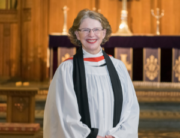A sermon given during 6:00pm Choral Evensong, by The Rev’d Dr Lynn Arnold AO, on the 24th September 2023.
Let me see the light
May the words of my mouth and the meditations of our hearts be worthy in your sight, O Lord, our Rock and our Redeemer. Amen.
‘Let me see the light’ – these are said to have been the death bed words of Samuel Sebastian Wesley, the composer of the beautiful anthem we have just heard – Thou wilt keep him in perfect peace.
Samuel Sebastian Wesley wrote this anthem when he was about forty years of age. The idea of God’s light was clearly an important theme in his life. Listen again to some of the words from the anthem:
God is light and with him is no darkness at all.
And
The darkness is no darkness with thee
But in the almost joyful certainty of such phrases, we sense elsewhere in the anthem, that Samuel Sebastian Wesley was not necessarily a man at peace when he wrote the anthem. Listen to what he also wrote:
Oh let my soul live …
Those words – ‘Oh let my soul live’ – set me on a mission to understand the composer better; to comprehend what condition or circumstance he had found himself at the time of composition. Indeed, I wondered whether he may well have been in his own personal profundum – that deep chasm enveloped in darkness but with a glimpse of light above.
At a public level, the man many saw when they encountered Samuel Sebastian Wesley was something of a curmudgeon. In a letter to his sister written when he was nearly 60, he wrote about one of his compositions:
My Chant Service is just the thing for rustics and those who make in their throats the noise Tom Francis calls Collywabbling … I don’t like this place at all. But don’t say so.[1]
This was no mere grumpiness of aging but apparently characteristic of the man his whole life. Gerald Spink, writing a brief biography of the composer in 1937, said of the young man:
He was not a scholar like his father, but he inherited from old Sam (his father) a love of writing, together with the gift of abuse which characterises so many of his letters.[2]
This the man who wrote ‘Thou wilt keep him in perfect peace whose mind is stayed on thee.’ Samuel Sebastian was clearly not kept in perfect peace however much he might have wanted to have his mind stayed on God.
This begs us to understand something of Samuel Sebastian the inner man, the man who in his anthem we hear crying out – ‘O let my soul live…’
Such details as are available to us are sketchy but suggestive. Spink wrote of the young composer:
His own embittered outlook in manhood is largely traceable to the precarious state of affairs in the Wesley household at the time of his birth and during his youth.[3]
Here is some of what we know: his father, Samuel [1766-1837] was a late born son of Charles Wesley, and a nephew of John Wesley. He was a talented musician but had a remote relationship with his father; estrangement led to his conversion to Catholicism and self-exile away from Bristol to London. Then, at the age of 21, he suffered serious head injuries in an accident that had far reaching consequences. Seventeen years after the accident, he would write to his mother:
I wish not to impress your mind additionally with my grievances; they are helpless and hopeless, unless God should please to work a Miracle for me, who am conscious of meriting no good from His Hands of any kind.[4]
Ten years later, when the young Samuel was only seven years old, in a period his father would refer to as a time of ‘Trouble and Anguish’, the elder Samuel attempted suicide. The wife of a close friend wrote of him at this time:
A man in its opposite extremes of mad fun and excessive depression … I knew him, unfortunately, too well; pious Catholic, raving atheist, mad, reasonable, drunk and sober – the dread of all wives and regular families, a warm friend, a bitter foe, a satirical talker, a flatterer at times of those he cynically traduced at others – a blasphemer at times, a puleing Methodist at others.[5]
The elder Samuel had married and had three children but, ten years before the younger Samuel was born, the marriage had broken down, though with no option for divorce. Unable to legally remarry, the elder Samuel then had four illegitimate children by his housekeeper, the youngest being Samuel Sebastian, born in 1810.
With such a troubled start to life, Samuel Sebastian may well have yearned from his earliest years for ‘perfect peace’. His anthem cry – Oh let my soul live – might well require of us an understanding that his beautiful anthem was more than just mere poetry but was a deep cry from the darkness of deep valleys through which the composer traversed.
Reading it this way, there is a sense to me that Samuel Sebastian Wesley was trying to find meaning in the circumstances and conditions he had found himself encountering. Listen to these words:
The darkness is no darkness with thee/ but the night is as clear as the day/ the darkness and the light to thee are both alike.
To anyone caught in the web of depression, such words might seem not only difficult to comprehend but almost offensive. Listen again to what he wrote:
The night is as clear as the day/ the darkness and the light to thee are both alike.
Someone who finds themselves in a chasm of darkness might surely cry out: ‘How can my darkness be light to God? Does He make light of my suffering? This is no balm but dreadful mockery by the divine of his creation.” Yet Samuel Wesley sought to provide a way through the potential contradiction of the words. He seemingly found that way through two steps – a cry – ‘Oh let my soul live’ and a direction – ‘Thou wilt keep him in perfect peace, whose mind is stayed on thee.’
In Berlin there is a Holocaust Museum which was designed by the architect Daniel Liebeskind. Underground, in the centre of the vast structure, is a room which is more in the nature of a chasm, a pit surrounded by the absence of any source of light at its base. The walls rise up closing in towards each other, appearing to want to seal off the pit at the apex; but there, far out of reach of human arms outstretched, there breaks a glimpse of light. It is as if, in concrete and space, Liebeskind has sculpted those two steps proposed by Wesley in his anthem – in the shadows of the bottom, one might want to scream out ‘let my soul live’; then, looking upwards to where no human effort could physically reach, see light breaking into the concrete chasm. There might the troubled soul, staying on that light, glimpse perfect peace.
From our Scripture tonight, we hear echoes of these messages of hope in dark places. Our psalm (145) assured us:
The Lord upholdeth all such as fall and lifteth up all those that are down. [v14]
And reminded us that, in reaching out to us, God seeks our seeking Him:
The Lord is nigh unto all them that fear him; he also will hear their cry, and will help them. [v18]
While our reading from Paul’s letter to the Romans, concluded with that wonderful assurance:
May the God of hope fill you with all joy and peace in believing, so that you may abound in hope by the power of the Holy Spirit. [Rom. 15:13]
I used the word profundum earlier; it is the Latin word for an abyss, a chasm. The opening verses of Psalm 130, known as the Song of Ascents, speaks of this place of dark profundity:
Out of the depths I cry to you, Lord;
Lord, hear my voice.
Let your ears be attentive
to my cry for mercy.
Samuel Sebastian Wesley, irascible and difficult may not have cared much for the opinion of others but by words and music he wrote, he seemed to want the Light at the apex of the chasm he was in to take note of his cry – ‘O let my soul live!’
Ten years before he wrote the anthem, Thou wilt keep him in perfect peace, Samuel Sebastian Wesley’s only daughter had died, she was only five years of age. The pain of her untimely death must have weighed heavily upon him for the rest of his life; for after he passed away on 19th April 1876, his expressed wish was that he be buried alongside his daughter. His last words before dying had been ‘Let me see the light’ – surely his words, borne out of the pain of his life, echo all our yearnings each time we pray, each time we come to worship, where we too, through whatever valleys we may have had to traverse, seek the ‘God (who) is light and (in whom) there is no darkness at all’ so that, as the anthem expressed it, our souls may live.
[1] G W Spink, Samuel Sebastian Wesley: A Biography (concluded), in The Musical Times, June 1937, Vol 78 #1132, p536.
[2] G W Spink, Samuel Sebastian Wesley: A Biography (pt 1), in The Musical Times, Jan 1937, Vol 78, #1127 (jan 1937), p44
[3] Op.cit.
[4] J I Schwarz, Samuel & Samuel Sebastian Wesley: the English ‘Doppelmeister’, in The Musical Quarterly, Apr 1973, Vol 59, #2, p196
[5] Op.cit. p197.





